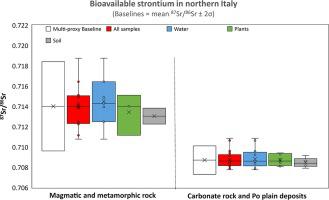Journal of Archaeological Science: Reports Pub Date : 2022-01-12 , DOI: 10.1016/j.jasrep.2022.103339 Pernille Ladegaard-Pedersen 1 , Robert Frei 2 , Anja B. Frank 1 , Massimo Saracino 3 , Roberto Zorzin 3 , Nicoletta Martinelli 3 , Flemming Kaul 1 , Kristian Kristiansen 4, 5 , Karin M. Frei 1

|
The evidence of prehistoric long-distance exchange networks in northern Italy is overwhelming, attested by several finds of non-local raw materials in Bronze Age pile-dwelling settlements of Lake Garda and eastern Po plain, like amber beads and bronze artefacts. Metals are dispersed throughout Bronze Age Europe from mining communities within the Alpine regions, and possibly local artefacts, like the Peschiera-type daggers, are known from archaeological records throughout Europe. This positions the region as part of organized networks of trade and communication connecting prehistoric Europe from north to south. This, however, does not in itself indicate a similar long-distance mobility of prehistoric individuals. To investigate individual, human provenance and mobility, the strontium (Sr) isotope methodology compares strontium isotope analysis of human remains to bioavailable strontium isotope baselines characterizing the regions of interest. We present here environmentally based, multi-proxy (water, soil leachates and plants) Sr baselines from the Lake Garda region. Our results show two separate baselines, roughly corresponding to the geographical distribution of rock types and erosional products thereof. One baseline is valid for the Lake Garda region, where Mesozoic carbonates are a dominant surface-near strontium source, and for the central Po plain north of River Po. We constrain this to 87Sr/86Sr = 0.7088 ± 0.0014 (2σ; n = 44) when including 9 compatible samples reported previously. The second Sr-baseline is valid for Alpine areas dominated by magmatic (basalts excluded) and metamorphic bedrock around the Fersina valley. We constrain this to 87Sr/86Sr = 0.7146 ± 0.0058 (2σ; n = 22) when including 11 compatible samples reported in previous studies. The baselines are compatible with previously reported results of other Sr proxies such as snails, archaeological fauna, and agricultural soils and products from the region.
中文翻译:

约束意大利北部加尔达湖地区的生物可利用锶同位素基线:一种多代理方法
意大利北部史前远距离交流网络的证据是压倒性的,在加尔达湖和波平原东部的青铜时代堆居住定居点发现了一些非本地原材料,如琥珀珠和青铜文物。金属从阿尔卑斯地区的采矿社区分散在整个青铜时代的欧洲,并且可能从整个欧洲的考古记录中都知道当地的人工制品,如 Peschiera 型匕首。这使该地区成为连接史前欧洲从北到南的有组织的贸易和通讯网络的一部分。然而,这本身并不表明史前个体具有类似的长距离流动性。调查个人、人类起源和流动性,锶 (Sr) 同位素方法将人类遗骸的锶同位素分析与表征感兴趣区域的生物可利用锶同位素基线进行比较。我们在此展示来自加尔达湖地区的基于环境的多代理(水、土壤渗滤液和植物)Sr 基线。我们的结果显示了两个独立的基线,大致对应于岩石类型及其侵蚀产物的地理分布。一条基线适用于加尔达湖地区,其中中生代碳酸盐是主要的近地表锶源,以及波河以北的波河中部平原。我们将其限制为 我们的结果显示了两个独立的基线,大致对应于岩石类型及其侵蚀产物的地理分布。一条基线适用于加尔达湖地区,其中中生代碳酸盐是主要的近地表锶源,以及波河以北的波河中部平原。我们将其限制为 我们的结果显示了两个独立的基线,大致对应于岩石类型及其侵蚀产物的地理分布。一条基线适用于加尔达湖地区,其中中生代碳酸盐是主要的近地表锶源,以及波河以北的波河中部平原。我们将其限制为87 Sr/ 86 Sr = 0.7088 ± 0.0014 (2σ; n = 44),当包括先前报道的 9 个兼容样品时。第二个 Sr 基线适用于以岩浆(不包括玄武岩)和 Fersina 山谷周围的变质基岩为主的高山地区。当包括先前研究中报告的 11 个兼容样本时,我们将其限制为87 Sr/ 86 Sr = 0.7146 ± 0.0058 (2σ; n = 22)。基线与先前报告的其他 Sr 代理的结果相一致,例如蜗牛、考古动物群以及该地区的农业土壤和产品。


























 京公网安备 11010802027423号
京公网安备 11010802027423号